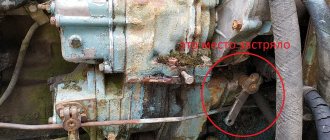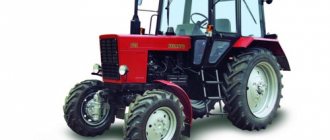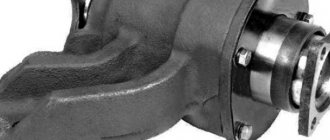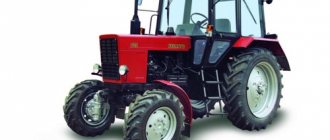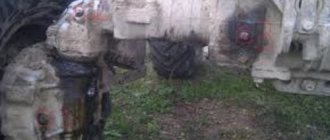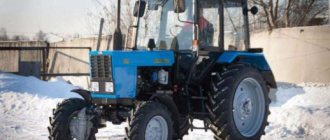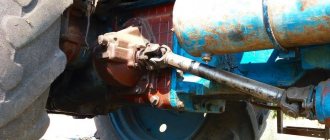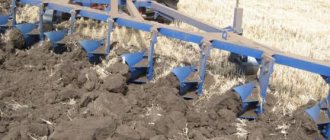To start the engine, the YuMZ tractor is equipped with a P-10UD two-stroke carburetor starter with electric start. Rotation from the crankshaft of the starting engine to the crankshaft of the diesel engine is transmitted by a transmission mechanism that has a clutch and an automatic shutdown mechanism. The starting engine is started and the transmission mechanism is controlled remotely from the driver’s seat.
Launcher device
The main parts of the launcher for YuMZ are a sealed crankcase, a cylinder with a head, a crank mechanism, a carburetor, an ignition magneto, a crankshaft speed regulator, and a transmission mechanism.
The starting motor housing consists of two halves with a vertical connector. To prevent them from moving relative to each other, two pins are pressed into their flanges. The crankcase halves are connected by four bolts. A sealing gasket is laid along the flanges of the connector halves. The lower flange of the starting engine housing is attached to the diesel flywheel housing with four bolts. A sealing gasket is also installed between the flywheel housing and the starting motor housing. There are seven threaded holes on the front wall of the crankcase through which the intermediate plate, magneto and regulator are bolted to the crankcase. The starting motor cylinder is cast from cast iron.
At the top, the cylinder has double walls that form a cooling jacket. In the outer side wall on the right side there is a window with a flange, closed with a plug. When installing a heater on a YuMZ tractor, instead of this plug, install a pipe through which coolant is supplied to the heater. On the opposite side of the cylinder there is a window with a flange for connecting a pipe supplying coolant from the diesel cooling system to the starting engine. In the lower part of the cylinder there are inlet, purge and exhaust channels necessary for the engine to operate on a two-stroke cycle. A carburetor is attached to the front of the cylinder, communicating with the inlet port, and at the rear there is an exhaust pipe. The cylinder is attached to the crankcase with four studs. A sealing gasket is installed between the cylinder and the crankcase.
The upper plane of the cylinder has windows for the passage of liquid from the cylinder cooling jacket into the head and four threaded holes for the cylinder head mounting studs. Inside the head there are cast cavities that form a cooling jacket. Between the head and the cylinder there is a gasket made of asbestos steel, the cylindrical cutout of which is edged with a steel piston. A pipe is attached to the flange on the side wall of the head, through which the coolant from the cylinder head is discharged into the thermostat housing of the cooling system. There are two threaded holes in the upper part of the head: the spark plug is screwed into the central one, and the decompressor is screwed into the side with a conical thread. At the bottom of the head there is a recess in the shape of a hemisphere, which is the combustion chamber.
YuMZ tractor starter diagram: 1 - flywheel; 2 - plug; 3 - gasket; 4 — connecting rod; 5 — exhaust pipe; 6 — compression rings; 7 - piston; 8 — decompressor; 9 — spark plug; 10 — drainage pipe; 11 — cylinder head; 12 — head gasket; 13—cylinder; 14 - pin; 15 — piston pin; 16 — carburetor; 17 — air cleaner; 18 — intermediate plate; 19 — thrust; 20 — outer regulator lever; 21 — adjusting bolt spring; 22 — adjusting bolt; 23 — regulator lever; 24 - drive disk; 25 - axis; 26 — ball stop; 27 - roller; 28 — regulator body; 29 — movable disk; 30 - balls; 31 - ball bearing; 32 — support disk; 33 and 34 - gears; 35 — intermediate gear; 36 — self-tightening cuff; 37 and 42 — axle shafts; 38 — front half of the crankcase; 39 - cheek; 40 - finger; 41 — rear half of the crankcase; 43 - felt seal.
The crankshaft of the starting engine is prefabricated and consists of two axle shafts and a hollow crank pin, pressed into the cheeks. The connecting rod head with a roller bearing is put on the pin.
The crankshaft is supported by two roller bearings (one on each axle shaft) and a ball bearing on the front axle shaft. A ball bearing, fixed by two plate spring rings, which are inserted into the grooves of the crankcase, keeps the shaft from axial movements.
The axle shafts are sealed with self-clamping cuffs that prevent air from leaking into the crankcase when the engine is running. In addition, a felt seal is additionally installed on the rear axle shaft, which prevents dust from entering the cuff. At the end of the front axle shaft of the crankshaft, a gear is mounted on a key. A flywheel is mounted on the conical end and key of the rear axle shaft. The gear and flywheel are secured with nuts.
The shaft cheeks are simultaneously counterweights that balance the inertia forces of the rotating masses of the crank pin and connecting rod. The connecting rod has an I-beam rod and two heads: the lower one is the crank and the upper one is the piston. With the lower head, the connecting rod is placed on the crank pin until it is pressed into the cheeks. A bronze bushing is pressed into the upper head of the connecting rod, which serves as a bearing for the pin.
To prevent jamming in the cylinder, the piston is made in a stepped shape. The piston head, which is subject to the greatest heating, has a smaller diameter compared to the skirt. The convex piston bottom facilitates better cleaning of the cylinder from combustion products. Two annular grooves on the piston head are used to install compression rings, which are secured against rotation by rods that fit into the cut (locks) of the rings. To avoid damage, the ring locks should not be located against the purge windows. Therefore, the piston in the cylinder is installed so that the arrow marked on its bottom faces towards the exhaust ports, i.e. towards the flywheel.
Starting motor PD-10: characteristics and design
One of the most important components in the design of various types of motorized equipment is the engine starting system. The reliability of operation, the speed of switching on the motor, and therefore its correct operation directly depend on it. The PD 10 launcher is installed on MTZ tractor equipment, which is rightfully considered the most common.
How the launcher works
The PD 10 starting motor is designed to ensure stable starting of the engine of MTZ tractors; it stands out among other analogues with its excellent technical characteristics and high stability of operation. It is a standard launcher equipped with one cylinder. Its working volume is 0.346 liters, which is quite enough to start the engine even in unfavorable conditions. The power of the unit at 3.5 thousand revolutions reaches 10 hp.
Having studied the technical characteristics of the product, it should be noted that it is of a two-stroke type and is equipped with a crank-chamber purge. The engine runs on a gasoline mixture, the quality of which is regulated using a carburetor, which allows for finer tuning of the engine. The operating principle of such a device is extremely simple.
First, the PD-10 is started through a standard tractor starter, after which it is connected to the main engine of the vehicle. With the help of mechanisms, rotational energy is transferred to the gearbox and, subsequently, the tractor crankshaft gains the necessary speed for stable independent operation. After the main engine has reached operating condition, the starting analogue stops operating.
Diagram of the PD-10 starting motor
The starting motor of this brand consists of a number of components and appears to be a complex technical unit designed to ensure a stable start of the MTZ tractor engine. Studying its structure, the following key design elements can be identified:
These elements are key and take the most active part in the operation of this engine. At the same time, there are many other components, such as pins, rings, windows and other components.
PD-10 maintenance
As a rule, the launcher will not require much time from the owner to carry out maintenance work on the unit. It is important to remember that using fuel in its pure form, without first mixing it with oil, is strictly prohibited, as this can lead to engine damage and subsequent failure.
In order to refuel the engine, you will need to mix pure gasoline of proper quality and motor oil in a clean container, strictly observing the proportions of 15:1. When refueling, it is necessary to use a special filter funnel, which will prevent large and small contaminants from entering the internal components of the unit.
As you use it, you should wash the fuel tank sump, and promptly wash or replace the air filter. It is recommended to do this every 480 hours of use. Since many problems that arise with the starter are associated with unsatisfactory cleanliness of the air filter, it should be periodically removed and cleaned, following the following instructions:
It is necessary to pay due attention to the maintenance of the gearbox operating in conjunction with the PD-10. First of all, the oil should be changed after 960 hours of operation, and topped up every 480 hours, as needed.
The functionality of the clutch assembly should be checked at similar intervals. During operation, it is necessary to remember that the operating time of the launcher should not be more than 10 minutes, otherwise the likelihood of its failure increases significantly.
Setup and adjustment
Its technical performance, as well as the stability and efficiency of operation, depend on the correct tuning of the engine, including the PD 10u. Adjustment of the device is carried out in several stages, the first of which is considered to be setting the carburetor.
To do this, you should set the length of the rod between the damper and the regulator, and then adjust the engine operation at low speeds. After this, they begin to adjust the crankshaft, which can be done using the appropriate spring. The more it is compressed, the higher the engine speeds.
Then, you need to start setting up the ignition system, and the last, final stage will be setting up the mechanism responsible for turning off the drive gear.
Conclusion
PD-10 can be called one of the most important components installed on tractors manufactured by MTZ. They have the necessary characteristics for stable engine starting and are unpretentious in maintenance and care. Thanks to this combination, the 10 series launchers have become incredibly widespread.
Instructions for starting Belarus MTZ and YuMZ tractors from a launcher or tug
With regards to starting the MTZ 80 (82) tractors, as well as the YuMZ 6, which is related in design and traction class, depending on the design of the starting system, they are started directly from an electric starter or from a PD 10 starting gasoline engine. In turn, the starting engine itself can be started manually or with an electric starter . And also, as an exception, which in our conditions often takes on the traditional method, the tractor can be started from a tow or roll. To understand how to control the tractor starting system from the starting engine, the article describes practical step-by-step instructions and provides recommendations based on the experience of practitioners when operating this system.
Starting motor PD-10M: diagram, device, principle of operation. Launcher PD-10
In the modification of the D 240 L engine of the Belarus tractor, starting is carried out using a two-stroke gasoline starting unit. Unlike electric starting, the advantage of the system is the ability to crank the diesel engine for a long time with powerful torque, which is not limited by the resource and state of charge of the batteries, which is especially important when starting a diesel engine in the cold season. The starting engine itself can be started either from an electric starter or from a manual drive using a cable wound on a special recess in the flywheel.
Operating principle of the PD-10 carburetor
Before starting work (that is, before turning on the engine), it is necessary to close the damper, at the same time, under the action of the control spring, another damper, the throttle, closes. After stopping the engine for a long time, you will need to pull the drowner lever. The diaphragm acts on the lever, the valve opens, and with it the passage for fuel into the chamber.
The fuel is discharged by rotation of the crankshaft, after which it enters the mixing chamber. It mixes fuel with air, resulting in a mixture that is over-enriched with oxygen. All these processes ensure immediate starting of the carburetor and engine.
After starting, the fuel loses a significant proportion of oxygen; this simple job is performed by an automated air damper valve. Gradually this valve opens wider and wider.
Starter PD-8 of the T-40 tractor (starting engine)
The T-40 tractor is equipped with a PD-8 carburetor two-stroke starter with a crank-chamber loop purge. The engine is air-cooled from a centrifugal fan wheel with air supplied to the cylinder fins. The starting unit is installed on the engine together with the gearbox. The starter gearbox is designed to reduce the rotation speed while transmitting torque from the starter crankshaft to the engine flywheel.
Thanks to the presence of an overrunning clutch in the engagement gear and clutch, the drive mechanism ensures the connection of the starter with the engine during the startup process and their separation after the engine starts.
Device PD-8: 1 - gear; 2 - screw; 3 - nut; 4 — regulator lever; 5 - magneto; 6 — crankshaft gear; 7 - coupling; 8 - traction; 9 - finger; 10 - electric starter; 11 - gasket; 12 — exhaust pipe; 13 - cylinder; 14 — exhaust pipe; 15 — piston pin; 16 - piston ring; 17 - piston; 18 — cylinder head; 19 — casing; 20 - high-voltage wire; 21 — spark plug; 22 — muffler; 23 — inlet pipe; 24 - carburetor; 25 — drowning button; 26 — air cleaner; 27 - cover; 28 — throttle lever; 29 — starting device; 30 — connecting rod; 31 - ratchet; 32 - flywheel; 33 — casing; 34 — fan rotor; 35 - crankshaft; 36 - crankcase.
Adjusting the crankshaft speed of the starting engine
A small-sized centrifugal ball regulator is designed to limit the maximum crankshaft speed. The crankshaft speed is adjusted only after repairing the unit, or when replacing the carburetor or regulator, if the factory settings are violated. This work must be performed by a qualified specialist.
Before adjusting the crankshaft speed, it is necessary to set a certain length of rods with the engine not running. The sequence for adjusting the rods is as follows:
1. connect the assembled rod to the throttle lever using a coupling;
2. Pull the rod to the left as far as it will go, while setting the throttle lever to a position in which the throttle is fully open.
The minimum crankshaft rotation speed at idle is adjusted with the engine warm and running. Using the carburetor idle screw, the quality of the working mixture is adjusted, maintaining stable idle speed. To do this, do the following:
1. Turn out the stop screw so that you can completely close the throttle valve;
2. fully open the air damper by moving the rod towards you;
3. Set the throttle valve to achieve minimum rotation speed;
4. Turn out the idle screw completely, and then, slowly unscrewing it, determine the position in which the starting unit will operate stably at minimum crankshaft speed.
Having completed the adjustment, tighten the screw until the throttle lever stops until the position at which the starter of the T-40 tractor will operate stably at minimum speed. The minimum stable rotation speed should be no more than 1200 rpm. Next, the maximum rotation speed is adjusted with pre-heating of the starter using a special regulator screw. When the adjusting screw is unscrewed and the spring is loosened, the maximum idle speed decreases, and when the screw is screwed in and the spring is tightened, it increases.
It is prohibited to adjust the crankshaft speed of the T-40 starting engine by tightening the hinges or changing the length of the rods.
YuMZ-6 How to start from the launcher? How to change gears?
Hello.
Rights cat. I have a little ability to drive, although in ordinary passenger vehicles, nothing more. I would be grateful if you could tell me the basics so as not to cause trouble for myself and the tractor. How to start from the launcher? I open the gasoline tap, open the valve on the carburetor and pump gasoline to the carburetor. Next, turning the lever toward you all the way, I open the starter with the flywheel crown, and start the starter with a wound shmorgalka. While the starter is working, I sharply pull the lever all the way away from myself, thereby connecting the starter to the diesel flywheel, then I see and hear that the diesel starts to work and the exhaust is coming out, using the button on the magneto I turn off the starter and turn off the gasoline. Right? Don't you have to open the lever again? And what kind of gasoline should I pour into the starter? How to change gears? Is it necessary to do all sorts of double squeezes and gas changes? It seems that the tractor gearbox does not have a synchronizer. For practice, I tried to drive from a standstill in first, so I pressed the clutch and put it in well, but sometimes it’s still quiet but crunching. Or is it a tractor and there should be some sounds from the gearbox? Is the hydraulic pump turned on by a lever next to it? It’s just that when I need to lift something with the lever in the up position, I turn it on, and when I don’t need it to avoid wear, I turn it off, right? Thank you for your responses! open the choke on the carburetor
After starting, open the damper.
Don't you have to open the lever again?
what kind of gasoline to pour into the starter
Yes, at least some. You won’t find 76 anyway.
double squeezes, re-throttles?
It’s just that when I need to lift something with the lever in the up position, I turn it on, and when I don’t need it to avoid wear, I turn it off, right?
If you plan to work for a long time without hydraulics, it is better to turn it off. And you definitely don’t need to pull it several times a day.
Source
PD 10 launcher
A feature of carburetor engines is their operation at any speed, for this reason they are often included in the design of the starting system of diesel power units. One of the common types of such devices is the PD10, a launcher characterized by high performance and efficiency. Such mechanisms have a non-standard fuel supply system, the characteristics of which allow them to be operated in low temperature conditions.
Operating principle
The PD10 starting engine is a standard gasoline power unit with one cylinder . Therefore, the principle of operation of the starter is similar to that of a two-stroke engine. In simple words it can be described as follows:
Fuel for PD10 is a mixture of gasoline and oil in a ratio of 15:1. Motor oil in the mixture is necessary to ensure correct lubrication of all interacting elements of the power unit, preventing its overheating and failure.
Starting is a single cylinder petrol engine
Technical characteristics of the PD10 starting motor
The two-stroke single-cylinder petrol carburetor engine has the following characteristics:
These are the most optimal parameters of the mechanism, thanks to which the correct start of the diesel power unit is ensured.
Design features of the starting motor
Let's consider the PD10 device. The starter has a design that is standard for all two-stroke engines, which is represented by the following elements:
The design of the crank mechanism for engines of this type is not complicated. In turn, the crankshaft has a prefabricated structure, each of the elements of which corresponds to its own parameters, which ensures optimal operation of the entire mechanism. The connecting rod heads PD10 are made as a non-separable block. The connecting rod itself is aggregated with a crank pin.
The PD10 crankshaft bearing consists of two rows of rollers and is constantly lubricated and cooled with oil while the engine is running. Aluminum alloy is used as the material for the engine piston. The piston has two compression rings.
The fuel supply system has a standard design, which includes a gas tank, fuel supply line, and filter elements. Its simplicity ensures reliable operation of the PD10. The power unit is formed by a cylinder-piston group and a crankcase. The crankcase structure consists of two halves, fastened with pins. The crankcase houses the crankshaft bearings and gears, and its upper part goes into a cylinder with a piston, the inner surface of which has gas distribution channels.
The enrichment of the fuel mixture to power the unit is carried out in the carburetor, from which it is supplied to the cylinders through the crankcase purge channel. A spark plug is screwed into the central hole of the cylinder, and in the side hole there is a special tap necessary for supplying gasoline.
Starter maintenance features
The mechanism functions correctly and, if used correctly, does not require additional maintenance or complex adjustments. Important point: operating the PD10 on pure gasoline without adding motor oil is strictly prohibited, as this can lead to serious damage. The mixture of gasoline and oil is prepared in accordance with the ratio of 15:1. Any clean canister of appropriate capacity will do for this. To fill the tank, a special watering can with a filter element is used.
During operation, you should monitor the condition of the fuel and air filters and change them in a timely manner, since the correct functioning of the mechanism depends on this. How to clean the air filter:
One of the main components is the starter gearbox. The essence of its maintenance is the mandatory replacement of lubricating fluid after 960 hours of operation, as well as replenishing its level after 480 hours of operation.
Adjustment and repair of PD10
Please note that the launcher's operating time is limited to 10 minutes, so if the unit is operated for more than this time, it may fail at any time . The uninterrupted functioning of the starter depends on the condition and performance of the main diesel engine that it starts.
Let's describe the most common breakdowns of the starting motor:
How to start a tractor in winter?
Not every beginner knows how to properly start a tractor in winter. Because of this, first of all, the engine of an agricultural machine suffers, since in inept hands, when starting in winter, it is subject to accelerated wear.
Many modern tractors are equipped with special heating systems that allow you to start the engine even in the coldest weather. This system is designed to heat the coolant and oil in the tractor engine crankcase to the optimal temperature. If necessary, you can purchase a heating system separately.
To start the tractor in cold weather using the heating system, you must proceed in the following order:
By strictly adhering to this algorithm, the farmer will be able to start the tractor engine without the risk of subjecting its main working mechanisms to excessive loads.
Carburetor for PD 10 - adjustment and device
On PD 10 a horizontal carburetor with one chamber is installed. A special diaphragm located inside it regulates the fuel input to the dosage elements. The process is fully automated, so the likelihood of failure is minimal.
The design of the PD 10 launcher carburetor is quite simple; unlike other analogues, you will not find a huge number of small parts in it that constantly fail or get lost.
Particular attention should be paid to the dosing system and the idle system. Even minor damage to these components can lead to serious problems.
Dosing system complete set:
The idle system consists of the following elements:
The diaphragm divides the entire body into 2 chambers: lower and upper. The lower one is located under the diaphragm and the cover, and the upper one, respectively, is above them. Through a special valve it communicates with the fuel tank, and the outlet holes and spray nozzle communicate with the carburetor chamber of the starter PD 10. The lower part has access to the atmosphere through a balancing hole. A spring under the influence of a lever can close this valve.
Carburetor diagram: 1 - air damper; 2 — diffuser; 3 — throttle valve; 4 — fuel supply fitting; 5 — fuel valve spring; 6 — nozzle-spray; 7 - valve; 8 — valve seat; 9 — housing cover; 10 - diaphragm; 11 — balancing hole; 12 — drowner button; 13 — idle valve; 14 — idle hole; 15 — idle fuel jet; 16 — idle speed adjustment screw; 17 — idle air channel; 18 - fuel channel; 19 — fuel channel saddle; 20 - fuel filter.
Idling
After the moment when all engine mechanisms start, the throttle valve closes, and the air valve, on the contrary, moves apart. There is a small discharge in the B-diffuser, so the fuel remains in the chamber.
The length to which the throttle is set directly affects the idle speed of the crankshaft.
Carburetor operation under high loads
There are often cases in which the mechanisms experience excessive loads. So what happens in such situations in the carburetor itself?
Over time, the volume of fuel located in the tank cavity decreases, and the diaphragm pressure decreases. And the pressure under the diaphragm undergoes only minor changes.
A pressure difference arises, the diaphragm touches the lever, and the valve opens. The upper chamber is filled with a new batch of fuel. When there is not enough space in the tank, the pressure in both parts returns to normal and the hole closes again. This cycle can be repeated endlessly.
Carburetor adjustments
Adjustment is made using several screws:
In different variations of the carburetor, other additional screws may be present. But they all change how the engine operates at idle. It is worth remembering that idle speed itself is very unstable, which is why all these adjustment tools exist.
Adjusting the carburetor of the starter MTZ 80
If you need to adjust the MTZ 80 launcher, I recommend that you watch this video, here is an excellent starting manual carried out by professionals.
Setting the carburetor to 16 for the starting engine
If you have installed a 16 carburetor on your starting engine and need to adjust it, I recommend watching this video.
Stages of starting the MTZ 80 tractor from the launcher
For a complete picture, we describe the most complex process of starting a diesel tractor from the starting engine using a hand cable.
Preparing the tractor
Before starting, a standard inspection of the tractor is carried out: fastenings of the transmission housings, engine and chassis tightening, as well as components of all systems. For a safe and successful launch, perform the following checks and actions:
Starting the starter motor
Considering the simplified design of the muffler and the direct exit of the PD 10 exhaust gases, you need to be mentally prepared that you will perform all actions during launch in the conditions of the loud noise of the launcher.
Starting the MTZ, YuMZ tractor from a tug or roll
The advantage of a diesel engine is that the mixture in the cylinder is ignited by compression. Many machine operators take advantage of this characteristic by starting a diesel engine, as they say, from a pusher or tug. For a diesel engine with a satisfactory condition of piston and serviceable fuel equipment, one rotation of the engine is enough for one of the cylinders to enter the compression stroke and start. Even a small hillock, on which the tractor is prudently parked, is enough to start the engine coasting.
The MTZ 82(8o) tractor is started from the coast or with the help of a tow from the 3rd or 4th gear, the YuMZ 6 - from the 1st or 2nd higher gear.
Source
Instructions for starting Belarus MTZ and YuMZ tractors from a launcher or tug
With regards to starting the MTZ 80 (82) tractors, as well as the YuMZ 6, which is related in design and traction class, depending on the design of the starting system, they are started directly from an electric starter or from a PD 10 starting gasoline engine. In turn, the starting engine itself can be started manually or with an electric starter . And also, as an exception, which in our conditions often takes on the traditional method, the tractor can be started from a tow or roll. To understand how to control the tractor starting system from the starting engine, the article describes practical step-by-step instructions and provides recommendations based on the experience of practitioners when operating this system.
Starting the MTZ, YuMZ tractor from a tug or roll
The advantage of a diesel engine is that the mixture in the cylinder is ignited by compression. Many machine operators take advantage of this characteristic by starting a diesel engine, as they say, from a pusher or tug. For a diesel engine with a satisfactory condition of piston and serviceable fuel equipment, one rotation of the engine is enough for one of the cylinders to enter the compression stroke and start. Even a small hillock, on which the tractor is prudently parked, is enough to start the engine coasting.
The MTZ 82(8o) tractor is started from the coast or with the help of a tow from the 3rd or 4th gear, the YuMZ 6 - from the 1st or 2nd higher gear.
Source
Starting the diesel engine.
After the starting engine has warmed up, start the diesel engine. To do this, do the following:
1. Turn off the friction clutch and engage the diesel flywheel drive gear, to do this, move the lever toward you, and a click should be heard.
2. Smoothly engage the clutch of the transmission mechanism by moving the lever away from you. If at the same time the rotation speed of the starting engine begins to decrease rapidly, which indicates insufficient heating of the diesel engine, turn off the friction clutch, wait until the starting engine picks up speed and turn the clutch back on. Make sure you turn the clutch on and off correctly, the lever must be in one of the extreme positions , otherwise the clutch slips, and the release mechanism roller and the centering pin ball heat up from friction and can weld to one another.
Practical advice
Often, starting depends on the technical condition of the PD 10 piston group and clutch, ignition adjustment and power system. In practice, each tractor driver adapts to the specifics of the operation of his starting engine. Watching the start-up, we often see how the tractor driver, after starting the PD 10, carries out manipulations to maintain speed: moves the speed control rod connected to the throttle valve; additionally supplies fuel by pressing the carburetor diaphragm, ensuring a balanced fuel supply until stable operation is established.
Reasons for poor launch of PD-10
All violations are the result of incorrect adjustment or poor maintenance. condition of the ignition units and power supply system PD 10. Poor engine starting is often associated with:
Overfilling of gasoline is accompanied by flooding of the spark plug, which prevents sparking and ignition. Insufficient supply of the combustible mixture to the combustion chamber also does not provide conditions for ignition.
Troubleshooting
If the engine does not start, check the operation of the spark plug and magneto: remove the spark plug from the head and check for sparking by turning the PD 10 flywheel with the magneto armored wire spark plug on.
During normal operation, the spark plug should be a bright blue color. A dull, small, red spark is not sufficient to ignite. The reasons may be coking of the spark plug or its breakdown, incorrect setting of the magneto or breakdown of the armor wire.
First, clean the spark plug electrodes and check the gap between them, which should be within 0.6-0.75 mm. If the procedure does not produce results, replace the spark plug and check for sparking.
In case of negative results, apply magneto tincture. Remove the assembly cover and check the gap between the breaker contacts by rotating the PD-10 flywheel. At the moment of breakdown between the contacts, the gap should not exceed 0.35 mm. Often tractor drivers check the operation of the magneto without dismantling it by sparking from the exposed end of the armored wire to the tractor ground, rotating the PD10 crankshaft.
Magneto adjustment and ignition installation
For good spark formation, the rupture of contacts 9 of the magneto must occur at the moment the poles of the stator and rotor magnets of the device coincide. This moment is felt by resistance when the armature 10 is rotated by hand under the influence of a magnetic field. In this position the magneto will give maximum discharge. It is in this position that the magneto is mounted with its drive coupling 4 to the grooves of the PD10 drive.
Before installing the magneto, the starting motor piston is set to a position not reaching the top dead center of 5-6 mm, ensuring ignition timing. The position is determined by measuring the rod installed in the threaded hole of the cylinder head for the spark plug.
If it is necessary to adjust the ignition timing, turn the magneto housing to the appropriate side in the elliptical holes of its fastening. For early ignition on MTZ 80(82), turn the body all the way counterclockwise (as viewed from the magneto and carburetor mounting point), for late ignition - clockwise.
Evidence of too early ignition is detonation of the hot mixture, pushing the piston in the opposite direction of the working rotation, and exhaust gases break through the carburetor. In professional slang, tractor drivers call early ignition “the starter turned back.” Late ignition is indicated by incomplete combustion of the mixture when working with exhaust firing through the muffler, while the engine does not develop full power.
Stages of starting the MTZ 80 tractor from the launcher
For a complete picture, we describe the most complex process of starting a diesel tractor from the starting engine using a hand cable.
Preparing the tractor
Before starting, a standard inspection of the tractor is carried out: fastenings of the transmission housings, engine and chassis tightening, as well as components of all systems. For a safe and successful launch, perform the following checks and actions:
Starting the starter motor
Considering the simplified design of the muffler and the direct exit of the PD 10 exhaust gases, you need to be mentally prepared that you will perform all actions during launch in the conditions of the loud noise of the launcher.
Rotation transmission from PD 10 to diesel tractor
If the engine starts successfully, time is given for idle operation to stabilize the speed and warm up: in warm weather, 10-15 seconds is enough, in cold weather up to half a minute.
There is no need to perform any manipulations with the PD 10 transmission control levers after starting the diesel engine. The clutch and bendix will be disconnected automatically when the reverse power of the running diesel engine is transferred to the starter transmission. The clutch will disengage due to the operation of the overrunning clutch, the bendix will disengage due to the operation of the return spring when centrifugal forces act on the bendix latch weights.
The PD-10 starter simplifies the starting procedure, freeing the operator from the starting procedure using a cable.
Practical advice
Often, starting depends on the technical condition of the PD 10 piston group and clutch, ignition adjustment and power system. In practice, each tractor driver adapts to the specifics of the operation of his starting engine. Watching the start-up, we often see how the tractor driver, after starting the PD 10, carries out manipulations to maintain speed: moves the speed control rod connected to the throttle valve; additionally supplies fuel by pressing the carburetor diaphragm, ensuring a balanced fuel supply until stable operation is established.
Reasons for poor launch of PD-10
All violations are the result of incorrect adjustment or poor maintenance. condition of the ignition units and power supply system PD 10. Poor engine starting is often associated with:
Overfilling of gasoline is accompanied by flooding of the spark plug, which prevents sparking and ignition. Insufficient supply of the combustible mixture to the combustion chamber also does not provide conditions for ignition.
Troubleshooting
If the engine does not start, check the operation of the spark plug and magneto: remove the spark plug from the head and check for sparking by turning the PD 10 flywheel with the magneto armored wire spark plug on.
During normal operation, the spark plug should be a bright blue color. A dull, small, red spark is not sufficient to ignite. The reasons may be coking of the spark plug or its breakdown, incorrect setting of the magneto or breakdown of the armor wire.
First, clean the spark plug electrodes and check the gap between them, which should be within 0.6-0.75 mm. If the procedure does not produce results, replace the spark plug and check for sparking.

